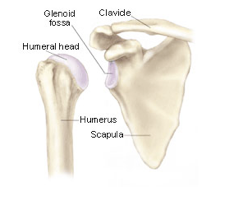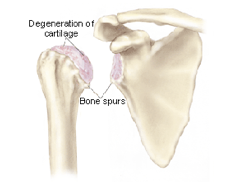Shoulder Osteoarthritis
Description:
The shoulder is a ball and socket joint. The ball (head of the humerus) sits in the socket (the glenoid fossa).
The end of each of these bones is covered by a smooth Teflon-like layer of tissue called articular cartilage. This layer allows these bones to glide smoothly over each other during shoulder motion.
Osteoarthritis, the most common form of arthritis, occurs when this articular cartilage wears away. Although arthritis is typically the result of gradual wear and tear of the cartilage, this process may also occur following previous injuries or surgeries. In addition to the loss of cartilage, in patients with arthritis bone spurs often develop in the bones of the shoulder joint.
Signs & Symptoms:
Patients with arthritis of the shoulder typically report pain throughout the shoulder. Pain is often worse at night; patients frequently report difficulty sleeping. Some patients complain of pain associated with weather changes. The pain is usually worse with certain motions. Some patients also report a grinding sensation in their shoulder with motion. As the arthritis progresses, there may be a loss of range of motion in the shoulder.
The diagnosis of osteoarthritis of the shoulder is typically made by a combination of the patient’s history, the findings on physical examination, and x-rays. Occasionally an MRI will be obtained to exclude an associated rotator cuff tear.
Treatment:
Treatment for osteoarthritis of the shoulder depends upon the severity of the arthritis and the patients symptoms. Initially non-surgical treatment methods are recommended; options include: ice, activity modifications, and medications (such as Tylenol or anti-inflammatory medications).
If these options fail to control the symptoms, cortisone injections into the shoulder may be attempted. If these injections are unsuccessful, shoulder replacement surgery may be recommended. In this surgery, the arthritic ends of the bones are cut away and replaced by metal and plastic components.

